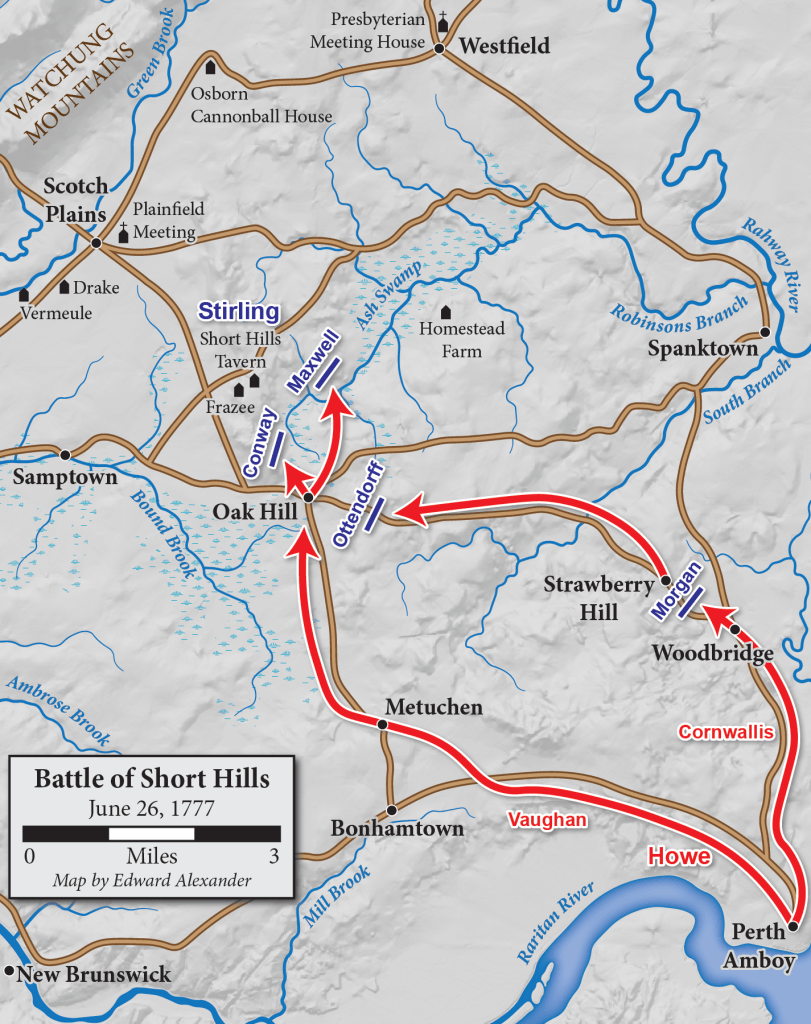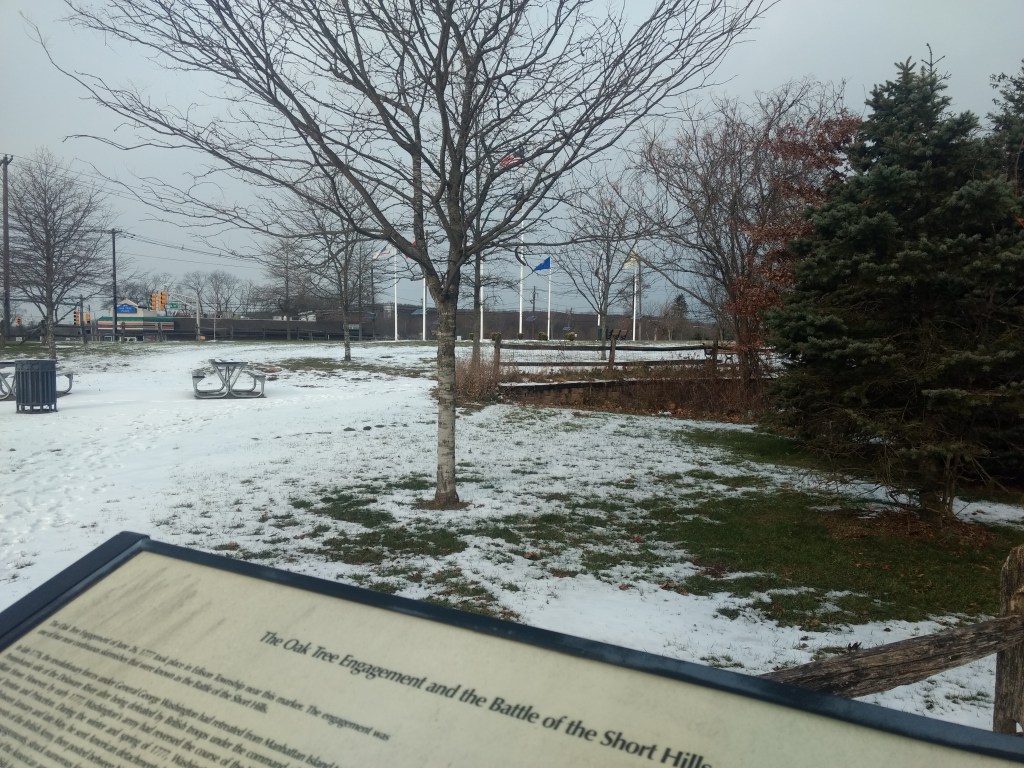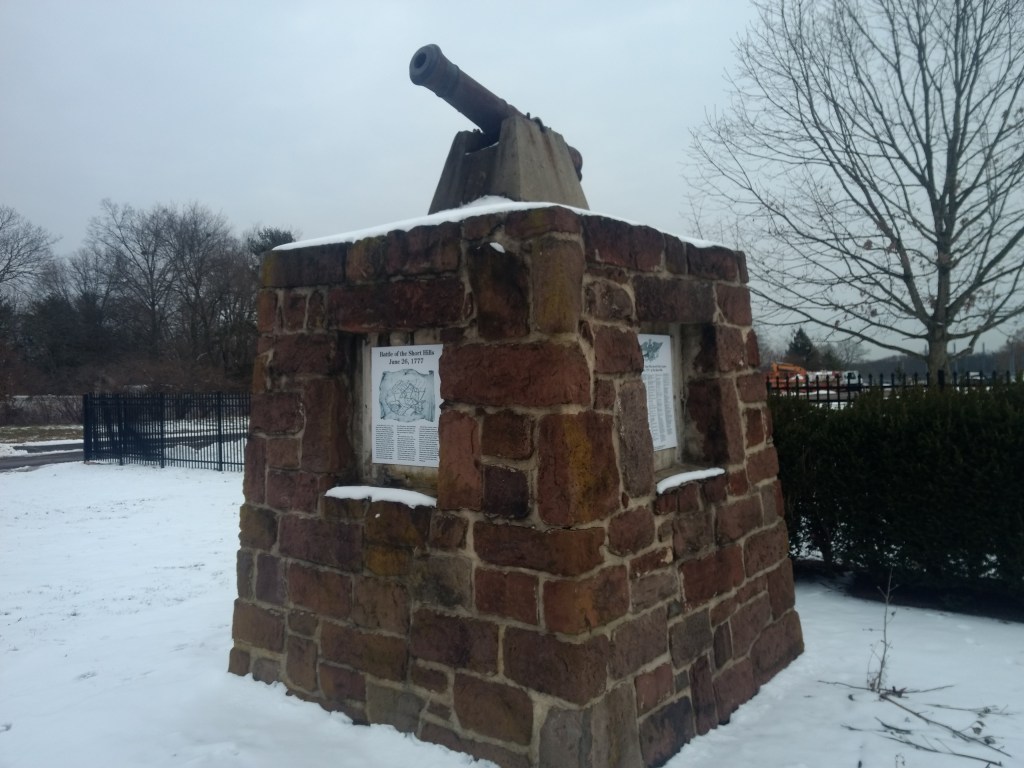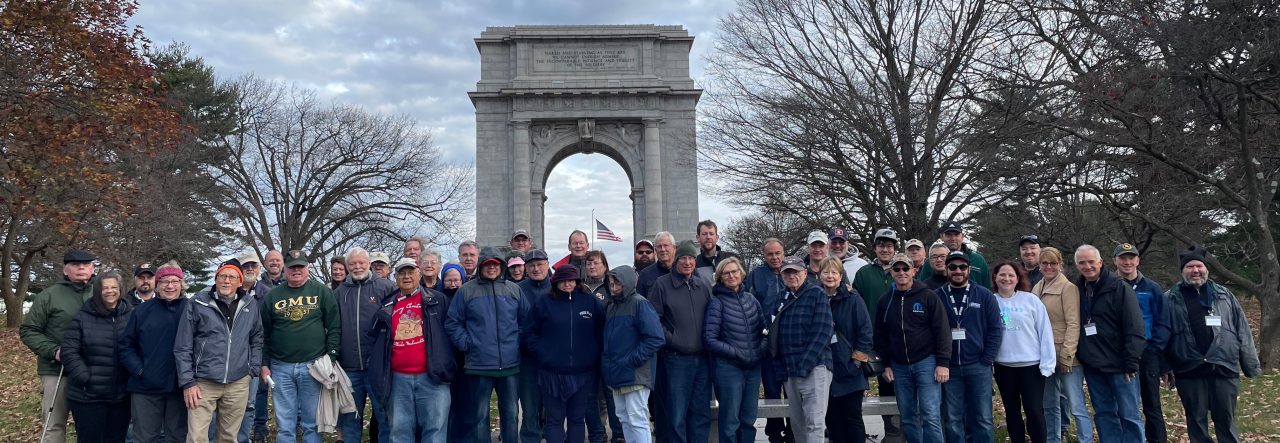Never heard of the battle of Short Hills, NJ? That’s’ not surprising, but its finally getting some recognition. It was the largest engagement since Princeton five months earlier, and was one of the first battles for the newly reorganized Continental Army.
In June, 1777 the main American force of about 8,000 was camped at Quibbletown in Middlesex County, not far from Perth Amboy and Staten Island, both occupied by the British.
British forces under General Cornwallis left Perth Amboy at one o’clock in the morning on June 25, 1777. They engaged the Americans in the Battle of Short Hills, near the modern Union/Middlesex County Line. Another column, led by General John Vaughan, accompanied by General William Howe, moved toward New Brunswick then turned north toward Scotch Plains by a more southerly route. They planned to destroy Stirling’s isolated division between the two wings, and force Washington into an engagement. Stirling had two brigades, Brigadier General Thomas Conway’s Pennsylvanians and Brigadier General William Maxwell’s New Jersey troops. In all Stirling had about 1,798 men, more than 16,000 were bearing down on him.

(map by Edward Alexander)
Daniel Morgan’s’ riflemen were present, and deployed in front of the main American force. They clashed with the British advance at Strawberry Hill, the modern Green Street/Route 1 intersection in Woodbridge. They Americans held off and bought valuable time until forced back by a bayonet charge.
Private Johann Dohla of the Bayreuth Regiment, wrote “Today an all-out attack by the detached troops against the rebels, a few miles from Amboy, was successful. The fire from large and small weapons continued from three o’clock in the morning until noon. The enemy had to retreat, leaving behind in his defenses seventy prisoners, including two captains, one hundred dead, and three cannon. On our side the losses were not as great.”

As the British under Cornwallis moved along Oak Tree Road, they next encountered Ottendorffs’s Corps, a unit of Pennsylvania Germans and foreign volunteers led by Major Nicholas Ottendorff. Joined by Morgan’s troops and militia, they engaged the British at about 8:30 where Oak Tree road intersects Plainfield Road and New Dover Road. Cornwallis’s men pushed them back and the Americans retreated to higher ground to the northwest, now occupied by water towers. Not long after the column of Vaughan and Howe arrived at the Oak Tree intersection and followed in the path of Cornwallis.
Arriving on a hill to the north of the Oak Tree intersection, Conway’s brigade deployed, supported by three guns. Together with the militia and rifleman who had already been engaged, they made a stand here.
Johann Carl Buttner of Ottendorff’s Corps wrote, “There we had command of the road that led around the hill, which we saw covered with a multitude of soldiers, and the newly risen sun glittered on thousands of bayonets.” He continues, “As soon as they came within range we fired our cannon at them. All at once, the endless marching line stood still, separated into divisions, and, then disregarding our fire, charged down the hill with fixed bayonets.”
Captain Frederick von Muenchhausen, a Hessian aide to General Howe, provides one of the best accounts of the battle:
Both columns continued on their march till about eight o’clock in the morning, during which time there was a steady fire on us from out of the bushes, and from behind trees. Their fire was answered by the Hessian Jaegers, the English light infantry and our side patrols. Then we met a corps of about 600 men with three cannon on a hill before a woods. They held their position until we approached them with some deployed battalions and cannon, whereupon they hurriedly withdrew into the woods behind them.
American artillery deployed to the north on high ground now occupied the site of the 4th through 13th greens of the Plainfield Country Club. Cornwallis’s troops forced the Americans back to New Dover Rd and Woodland Ave, toward the Short Hills. Cornwallis’ column advanced along Oak Tree Road, and linked up with that of Howe and Vaughan.
Maxwell’s’ brigade could not reach Conway’s at the crossroads so they moved to deploy at the Short Hills near Ash Swamp. The American line ran roughly along modern Tingley Lane and Rahway Avenue. Lord Stirling was on the scene with the New Jersey troops. After falling back, Conway joined them here.
The main battle began as Cornwallis’ roughly 5,000 troops assaulted the 2,500 of Stirling. The British also deployed 15 cannons. Local tradition maintains the use of a form of germ warfare, saying that some British and German troops had covered their musket balls with verdigris (copper acetate) in an effort to poison the Americans. British troops also found verdigris among military supplies captured after the battle from the Continental troops. The claim cannot be substantiated but is a part of local tradition on the battle.
As these events unfolded, Washington oversaw the withdrawal of the main army to Middlebrook, relying on Stirling to delay the British and buy time. Washington had no intention of fighting a major battle.
Few tangible reminders remain from the battle, but one is the Osborn Cannonball House in Scotch Plains. Owned by John and Mary Osborn at the time, the home was hit by American artillery firing towards the British. Several Osborn family members served in the war.
Captain Von Munchausen wrote of this part of the engagement:
On a bare hill before some woods, we came upon approximately 1500 men with six cannon. They started cannon fire early, at a distance of 1000 paces, and then began with small arms fire. We took two 12-pounders and several 6-pounders to our left flank, where we had some rising ground. From our right flank the Hessian grenadier battalion von Minnegerode ascending the slope in deployed formation, attacked their left flank. Our battalion had to move considerably to the right in order to outflank their left flank. The rebels continued a strong but not very effective fire upon us. They finally fired grape-shot at von Minnegerode’s battalion, but after that, they ran away into the woods
The British Guards charged with bayonets up a hill, and the Grenadier Company captured three cannons. Sergeant Thomas Sullivan of the 49th Regiment noted that his men attacked with such vigor that the Americans “could not long maintain their ground against so much Impetuosity, but were soon dispersed on all sides, leaving behind three Pieces of Brass Cannon, 3 Captains and 60 men killed, and upwards of 200 Officers and men wounded and taken.”
Captain Johann Ewald of the Hessian Jaegers wrote, “The enemy had taken his positon on the steep bush-covered heights; his right was protected by deep ravines and his left by a thick wood. The jagers tried to approach the enemy in the rear though the ravines, and the Hessian grenadiers made an attack on the right, supported by the Guards. The Enemy was attacked with the bayonet and driven back, whereby Colonel Minnnigerode and his grenadier battalion greatly distinguished themselves, taking from the enemy three Hessian guns which had been captured at Trenton.”
General Stirling himself had a close call. A Continental officer observed that, “The fire growing hot, and our beginning to retreat, a British officer singly rode up to a cannon that was playing on the enemy, and with his pistols and hanger (sword) forced every man from it, then seeing Lord Stirling he cried “Come here you damned rebel, and I will do for you.” Lord Stirling answered him, by directing fire of four marksmen upon him, which presently silenced the hardy fool, by killing him upon the spot. Our men recovered the field piece which their want of small arms obliged them to abandon.”
The fighting at Short Hills raged for about two hours, significant for troops who were new to sustained head-on combat. They had tasted combat before, but never fought as brigades, and never in such a large engagement. By about noon the Americans began to waver.
Colonel von Donop of the Hessian Grenadiers wrote that here the Americans occupied a “fairly steep hill.” Major Benjamin Tallmadge, commanding American Light Dragoons, noted “in the course of the battle, four field-pieces were taken from Lord Stirling, and again retaken, and finally lost.”
William Grant, a Virginia rifleman in Ottendorff’s Corps, described how “They drew up immediately in order to defend their field pieces and cover our retreat, and in less than an hour and a half were entirely cut off; scarce sixty of them returned safe out of the field; those who did escape were so scattered over the country that a great number of them could not rejoin the Army for five or six days.”
Johann Carl Buttner of Ottendorff;s Corps wrote, “When we saw that we were outnumbered and resistance was hopeless, we abandoned out cannon and baggage and fled down the other side of the hill. Many threw away their rifles and knapsacks, and ran like hares into the forest. I fell into a ditch and my comrades, leaving me for dead, jumped over me. As the cannon balls and rifle bullets were falling all around me, and I was afraid of being run through by the enemy that were pursuing us, I crawled on my hand and knees to some thick undergrowth nearby, and lay there until I could no longer hear any firing.”
The flanking attack by the Hessian troops proved the turning point. Captain George Ewing, attached to Maxwell’s Brigade, wrote that they “were nearly surrounded before we were aware . . . We were obliged to retreat which we did in good order.”
The day was intensely hot and humid, and many British troops fell out with exhaustion. In addition to his close call, Stirling’s horse was shot from under him. Maxwell was almost captured in the confused retreat. Losses were about 30 Americans killed and 50 wounded, British forces suffered 6 killed and 30 wounded.
The heaviest fighting took place on the grounds of the Plainfield Country Club. The terrain here matches with eyewitness accounts. A 2010 archaeological survey funded by a National Park Service grant found several battle related artifacts south of the Country Club.
Created in 1916, the Plainfield Country Club preserves the area as open space and has had minimal impact on the ground. To the east near Ash Brook Reservation, Homestead Farm in the Oak Ridge Golf Glub is a surviving colonial structure from the battle. Though it has been modified over time, much of the interior retains its historic integrity. This was likely a witness to the battle.
That night the British forces camped at Westfield, and meted out harsh treatment on the Westfield Presbyterian Meeting House. Known to be a center of opposition, troops used the meeting house for a slaughter house, throwing entrails into the pulpit before departing. Its bibles and religious books were also destroyed.
British, German, and Loyalist troops foraged liberally. Local civilians reported the loss of crops like wheat, flax, corn and rye, rails burnt, clothing stolen, and livestock driven off. General Howe’s forces moved on from Westfield on June 27, driving about 500 cattle and several hundred sheep with them to Rahway. They continued on to Perth Amboy, arriving on the 28th. Soon the British departed for Pennsylvania and the campaign to capture Philadelphia. Short Hills convinced Howe that Washington would not risk a major open-field battle in New Jersey.
On August 27 the National Park Service announced $2,887,423 in grants from the American Battlefield Protection Program to protect 221 acres of Civil War battlefields and 13 acres of Revolutionary War battlefields.
The Battlefield Land Acquisition Grant program, administered by the American Battlefield Protection Program, provides up to 50% in matching funds for state and local governments to acquire and preserve threatened Revolutionary War, War of 1812, and Civil War battlefield land through the purchase of land.
The County of Middlesex and Edison Township are receiving over one million dollars to preserve a bit over thirteen acres at Short Hills, and hopefully this will only be the start of preserving and interpreting this battle.


Nice article
LikeLiked by 1 person
Hope I’m allowed a genealogy related question. Was the 10th VA, or elements of it, at this battle? Particularly Strawberry Hill. Thanks.
LikeLiked by 1 person
Hill Bill, I don’t believe so. There were some Virginians with Morgan’s riflemen, but I don’t think from the 10th.
LikeLike
This is great news! Since so much of Rev War NJ has been paved over, any opportunity to save something… a period house or land… is a big win. FYI, the Frazee House in Scotch Plains that is sited on the map still stands.
Also, this is one of the best accounts of the Battle of Short Hills I have read! Great work Bert!
LikeLiked by 1 person
Thank you, I would love to see more historic site in NJ preserved!
LikeLike
Burt,
A fine study of the battle. So good to hear Middlesex County sought and received funding to protect a substantial piece of battlefield ground! Great to have your interest in RevolutionaryNJ. We were so fortunate to have you on NPS detail to Morristown NHP.
Regards,
Kevin Tremble
Past President
Washington Association of NJ
LikeLiked by 1 person
Thanks Kevin! I loved my time there!
LikeLike
It’s actually called the Battle of THE Short Hills, not the Battle of Short Hills or the Battle at Short Hills. Saying it in this manner distinguishes it from Short Hills the town. The hills where the battle took place are the short hill remains, or moraines, left from the glaciers that terminated in NJ thousands of years ago.
LikeLike
Thank you Mike, I’ll double check the primary sources.
LikeLike
The story and article are wonderful, Bert, and I truly appreciate it being told by you as the landscape has garnered this fantastic reprieve from development. I have a personal connection to this battle as I was one of the individuals who helped with the archaeological research of the hills under the request of the Metuchen-Edison Historical Society with Walter Stochel leading the effort for the organization. Doing the dig on the exact anniversary of the battle in 2010 added extra meaning to me as I grew up not far from the scene where these events took place 233 years prior.
LikeLiked by 1 person
Thank you, MIke.
LikeLike
I would also like to note that the caption under the cannon photo should say Ash Brook Golf Course and not the Plainfield Country Club.
LikeLike
Thank you for the correction, I’ll make a note of that
LikeLike
Very good observation on correct location of Monument My father designed the memorial and we helped set it all up at Ash Brook for the 1977 bicentennial. My book War in the Countryside, The Battle and Plunder of the Short Hills was published for the bicentennial and I have now almost completed work on a revised edition for the Revolution’s 250th.
LikeLike
Thank you for the correction.
LikeLike
June 26, 1777
LikeLike
In looking for the Battle of Short Hills I found your very useful article. My ancestor, John Van Dyke (1754-1840) also documented his involvement in this battle, though it took me a while to even know there was such a battle. Here is his report from the viewpoint of an artillery 2nd Lieutenant:
I joined the army at Morristown. Ordered by General Knox to Chatham under Major General Stephen, from Virginia- on the Morristown road – to Elizabethtown. This winter we marched march near Bonhamtown which was occupied by the British near New Brunswick. We took about 1,500 head of horses, cattle & sheep and returned to Chatham. In April we marched joined General Washington’s Grand Army at Middle Brook – the British was in New Brunswick under General Knyphausen. British about leaving New Brunswick for Port Amboy – General Maxwell’s Jersey & General Conway’s Pennsylvania Brigades under Major General Sterling’s Division marched after the British, we had gotten in the neighborhood of Woodbridge –the British was seen coming from Port Amboy to Statin Island. It was late in the evening we found the enemy was gone & crossed to Statin Island and two brigades lay in houses & barns at night. The next morning Conway’s Brigade was marching up to join Maxwell’s Brigade when they disarmed the enemy – the enemy got between the two Brigades. Conway was on the North and in a field to the right & engaged. The armies of the Jersey Brigade was attached in a field behind the (missing corner of Doc) & the men scattered over the fields, all had to run & take up arms (missing corner) a defense to form – I ran taking my two muskets to leave the ground was marched & got in what is called Short Hills – fell in with the enemy & engaged & when we got shot ( the British from Brunswick outnumbered us by 4 to one) – ordered to rally at Scotch Pines, I lost my piece, two more pieces of artillery was taken. I was spotted close within a road fence. The Brigade on the left about two hundred yards to the left & in the rear by Capt.Vettece commanding the two companies of artillery. I was ordered to form with the Brigade. Just as I had ordered to draw the piece to the limbers – General Sterling came up & ordered me up to the fence on a eminence (piece of rising ground), over shot the fence & across the road at a column of Hessians until their front jumped over the first fence & was half acer across the road – my piece and one other was taken. I marched with only one limber with an ammunition cart with the rest of the artillery officers to grand camp at Middle Brook & reported General Knox – that the artillery was lost not being supported by General Sterling, we called or requested a court of inquiry, obtained one. It was requested with honor. The loss of the pieces was adjudged for want of being supported – I refer this to our Honorable the President Monroe for the truth of my accusations – he then was aid to Major General Sterling.
LikeLike
Thank you so much for sharing this! Wonderful account. I’m curious, what is the source? Thanks!
LikeLike
Hi Bert, I too have come across Van Dyk’s writings. These are his recollections post-Revolution. Only the photostats exist at the New York Historical Society (he was friends with founder John Pintard), 7 or 8 pages, but I do not think they have ween deciphered until Andrea and I did it recently. I have been researching Van Dyk quite extensively as he served the entire war, help Alexander Hamilton remove the cannon from the battery in NYC while fired upon by the HMS Asia, wintered at both Morristown and Valley Forge, was captured and put on the Jersey prison ship, was one of four officers to accompany Major John Andre to the gallows and an original member of Washington’s Society of the Cincinnati. He fought at least 10 battles including Trenton, Brandywine, White Plains, Harlem Heights, and Monmouth.
LikeLiked by 1 person
Great addition to the story of the battle. My book War in the Countryside, The Battle and Plunder of the Short Hills was published for the bicentennial and I have now almost completed work on a revised edition for the Revolution’s 250th. DO you have a copy of the original document? Thank you, RIck D.
LikeLike
Hi Frederic, yes I do! Great work! Glad you are revising it for the 250th!
LikeLike